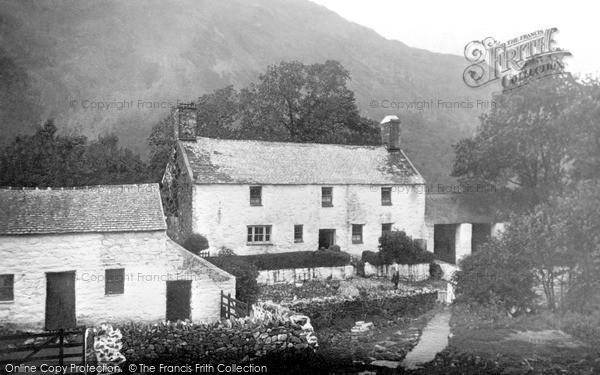Twelve Happy Months
A Memory of Nantgwynant.
I was born in Nant Gwynant in 1925 and lived there for the first 20 years of my life. In 1944 I was drafted into the army and served in German and Italy. Upon release in 1947, I decided to try and make a career in agriculture and before undertaking a college course Brooksby Hall, Melton Mowbray, I had to gain experience of farming for 12 months, and this was done at Hafodlwyfog Farm. It was then owned and run by William and Myfi Jones, both of good old Welsh stock. I had to undertake all aspects of farm work. There was a small milking herd of about 12 cattle I think. These would be hand milked twice a day at about 7:30 in the morning and 4:30 in the afternoon. The farm buildings were quite a long downhill walk from the house, but I was lucky, because by then, the 10 gallon churns of milk were picked up by a milk lorry at the main road, where as before, the milk had to be carried in pails hooked to a yoke up the the dairy at the farm house. There was no water laid on in the shippons so the cattle, and followers, had to find their way down the stony path to Gwynant lake for their drink. I had read an old poem which describes how the Hafoflwyfog herd were once seen to be crossing the lake when it became frozen over. All the sheds had to be cleaned and manure take to a massive heap in the yard. In early spring, this had to be loaded with a 4 tined fork into a cart and taken, when the ground was solid enough to various fields in rotation and unloaded into small heaps, seven steps apart. These, later, would have to be scattered using the same fork, not a pleasant task, and later still broken up again by dragging over with a horse pulling a weighted wooden frame inter-laced with branches of silver berch or black thorn. It certainly made the grass grow.
Talking about grass, silage making was then becomming popular and William Jones decided that a pit should be dug in the sloping field below the main road wall. When the grass was ready, it was carted to a spot on the main road, above the pit, and the grass forked into the pit. (The traffic on the main road was very light then). It was hard work to carry the heavy silage to the animals in the winter but they appreciated it.
In the time I was there, Mr Jones bought a Fordson tractor. What a beast that was. It had to be started with a handle using petrol from a separate tank from the main fuel tank and then switching over to TVO when the engine was warm enough. Very often it wasn't and the process had to be started all over again and Mr Jones would not allow me to use a lot of petrol.
There was a biggish flock of sheep at Hafodlwyfog as there was a good acreage of mountain pasture. This necessitated gathering about four times yearly, for lambing, shearing, dipping and sorting out the yearlings to be taken to warmer climbs - Pwlleli and other areas for the winter months. I had a smashing strong dog called Don, who I could send out so far that he was only a little dot in the heather. I remember one day, I could hear him barking somewhere out of my sight and I thought he was just doing his work. He didn't come into sight for a long time and I had to climb to see what he was up to. I found him sitting under a tree barking at a squirrel up in the branches. Grrrrrrr.
Mrs Jones had a brother called William Hughes (Wil Oerddwr) who was a poet of some renown and he was quite a character and came to Hafodlwyfog on occasions for a bit of a holiday. On sheep gathering days, neigbouring farmers and their dogs came to help. Don, my dog, liked to scrap, and I often had to separate hom from another dog. My Hughes used to say "let them be, that's how dogs say good morning." Mrs Jones also had a cousin, the literary giant, R.H. Parry Williams, a chaired and crowned bard who came to visit at Hafodlwyfog. I wish I had realised then that I was in such eminent company.
What a happy period of 12 months I spent at Hafodlwyfog. There is an atmosphere in the old house. There is so much history there and how interesting it would be to delve into it. Only to look at the date "1638" carved into a beam in "the parlour" set ones mind thinking and wishing to know more.
Add your comment
You must be signed-in to your Frith account to post a comment.
Add to Album
You must be signed in to save to an album
Sign inSparked a Memory for you?
If this has sparked a memory, why not share it here?


Comments & Feedback